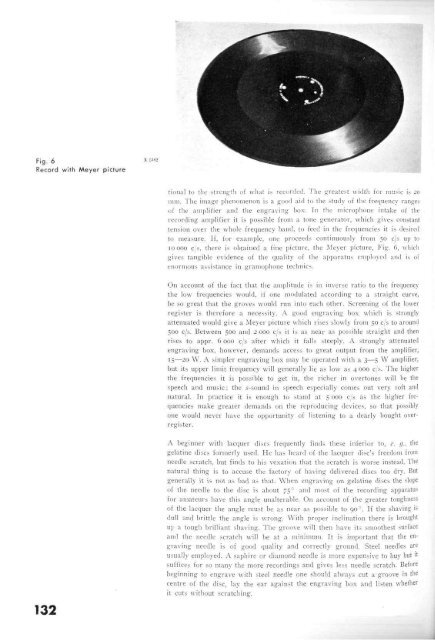contents - History of Ericsson - History of Ericsson
contents - History of Ericsson - History of Ericsson
contents - History of Ericsson - History of Ericsson
Create successful ePaper yourself
Turn your PDF publications into a flip-book with our unique Google optimized e-Paper software.
132<br />
tional to the strength <strong>of</strong> what is recorded. The greatest width for music is 20<br />
mm. The image phenomenon is a good aid to the study <strong>of</strong> the frequency ranges<br />
<strong>of</strong> the amplifier and the engraving box. In the microphone intake <strong>of</strong> the<br />
recording amplifier it is possible from a tone generator, which gives constant<br />
tension over the whole frequency band, to feed in the frequencies it is desired<br />
to measure. If, for example, one proceeds continuously from 50 c/s up to<br />
10 000 c/s, there is obtained a fine picture, the Meyer picture, Fig. 6, which<br />
gives tangible evidence <strong>of</strong> the quality <strong>of</strong> the apparatus employed and is <strong>of</strong><br />
enormous assistance in gramophone technics.<br />
On account <strong>of</strong> the fact that the amplitude is in inverse ratio to the frequency<br />
the low frequencies would, if one modulated according to a straight curve,<br />
be so great that the groves would run into each other. Screening <strong>of</strong> the lower<br />
register is therefore a necessity. A good engraving box which is strongly<br />
attenuated would give a Meyer picture which rises slowly from 50 c/s to around<br />
500 c/s. Between 500 and 2 000 c/s it is as near as possible straight and then<br />
rises to appr. 6 000 c/s after which it falls steeply. A strongly attenuated<br />
engraving box, however, demands access to great output from the amplifier,<br />
15—20 W. A simpler engraving box may be operated with a 3—5 W amplifier,<br />
but its upper limit frequency will generally lie as low as 4 000 c/s. The higher<br />
the frequencies it is possible to get in, the richer in overtones will be the<br />
speech and music; the i-sound in speech especially comes out very s<strong>of</strong>t and<br />
natural. In practice it is enough to stand at 5 000 c/s as the higher frequencies<br />
make greater demands on the reproducing devices, so that possibly<br />
one would never have the opportunity <strong>of</strong> listening to a dearly bought overregister.<br />
A beginner with lacquer discs frequently finds these inferior to, c. g., the<br />
gelatine discs formerly used. He has heard <strong>of</strong> the lacquer disc's freedom from<br />
needle scratch, but finds to his vexation that the scratch is worse instead. The<br />
natural thing is to accuse the factory <strong>of</strong> having delivered discs too dry. But<br />
generally it is not as bad as that. When engraving on gelatine discs the slope<br />
<strong>of</strong> the needle to the disc is about 75° and most <strong>of</strong> the recording apparatus<br />
for amateurs have this angle unalterable. On account <strong>of</strong> the greater toughness<br />
<strong>of</strong> the lacquer the angle must be as near as possible to 90°. If the shaving is<br />
dull and brittle the angle is wrong. With proper inclination there is brought<br />
up a tough brilliant shaving. The groove will then have its smoothest surface<br />
and the needle scratch will be at a minimum. It is important that the engraving<br />
needle is <strong>of</strong> good quality and correctly ground. Steel needles are<br />
usually employed. A saphire or diamond needle is more expensive to buy but it<br />
suffices for so many the more recordings and gives less needle scratch. Before<br />
beginning to engrave with steel needle one should always cut a groove in the<br />
centre <strong>of</strong> the disc, lay the ear against the engraving box and listen whether<br />
it cuts without scratching.
















